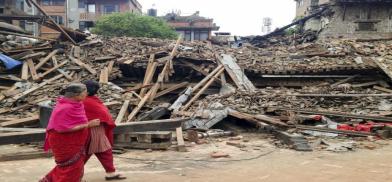Gendered impact of natural disasters: Vulnerabilities of women increased in a post-tsunami Sri Lanka
The worst part of the disaster was not only loss of resources like property but the sexual violence the women in Sri Lanka faced. Apart from lack of proper nutrition, hygiene and clean water and health care, what was impossible to handle was sexual violence along with high cases of rape and domestic abuse.

Disaster resilient societies have their in-built strategies developed to counter the natural fury of climate upheavals. Sri Lanka which is already a war-ravaged society with decades of military conflicts, is vulnerable to natural disasters too. This vulnerability is accentuated by traditionally defined roles that limit physical mobility and personal choices of women. This was reflected in their conditions while mitigating the aftereffects of the tsunami in 2004 which killed over 200,000 people (more women than men) and displaced more than a million in Sri Lanka. While the disability was detrimental to women what was more than disturbing was the susceptibility to Sexual and Gender Based Violence during the disaster and its violent repercussions. Disaster literature focuses on how men and women experience, deal with and respond to disasters differently.
'Die in the waves or be raped?'
In Sri Lanka despite high regional rating of literacy and health, pre-existing social inequalities and cultural matrix pre-condition women into subservient roles. War has already exposed social fissures which got aggravated by natural calamities like the 2004 tsunami. More women than men lost their lives in the disaster. According to a press release, women made up the majority of 13000 bodies recovered in Batticaloa District. A similar story was narrated by a member of Sri Lankan Association of South Wales. She surveyed a camp to find only 1000 women survivors while men and boys present were 1589. (The Tsunami’s impact on women, Oxfam Briefing Note, March 2005; URL: https://oxfamilibrary.openrepository.com/bitstream/handle/10546/115038/bn-tsunami-impact-on-women-250305-en.pdf). One reasons of this impact was because women were taking a bath when the disaster struck. They were caught unaware and hardly had any time to rescue themselves.
The worst part of the disaster was not only loss of resources like property but the sexual violence the women in Sri Lanka faced. Apart from lack of proper nutrition, hygiene and clean water and health care, what was impossible to handle was sexual violence along with high cases of rape and domestic abuse. Incidents of gangrape, rape, domestic violence and molestations in unsupervised rescue operations and temporary shelters or camps increased manifold. In a training programme aimed to build resilience of women in Colombo in January 2005 a woman victim of violence told that two men had pulled her from the waves and asked her, “What would you prefer-- to die in the waves or be raped and survive?” (‘Waves of Violence-Women in Post-Tsunami Sri Lanka’, Dr. Susan Rees, Dr Eileen Pittaway and Linda Bartolomei, The Australian Journal of Disaster and Trauma Studies, Vol 2005-2; URL: https://www.massey.ac.nz/~trauma/issues/2005-2/rees.htm). The woman decided survival was more important for her children so the men raped her. She felt terrified after the rape as she feared her husband will find out. Social taboos of victim-blaming are inherent in Sri Lankan society. The women have a low status in Sri Lankan society which limited their roles in disaster response and reconstruction work.
Temporary shelters and displaced peoples’ camps were unsafe. The toilets were poorly lit and there was lack of privacy. A woman living in a camp for displaced people told Oxfam about her experiences using the toilet facilities; -
“In the night we get scared because there are no lights. It’s frightening for us; we know there are snakes and you can’t see who is around the toilets and washing areas.” (The Tsunami’s impact on women, Oxfam Briefing Note, March 2005). A society which espouses violence and somewhat justifies it, domestic abuse is a huge challenge there and increased post-tsunami. P. Velunagagam, a field officer withy Sarvodaya, an Oxfam partner in Sri Lanka, experienced first-hand an incident of domestic abuse stemming from post-tsunami environment:
‘Last week there was a problem between a man and his wife. The government is giving people payments after they lost their relatives and houses in the tsunami. The husband went to claim the payment and spent it on arrack [ a local liquor made from palm sap] to get drunk. The wife asked where the money had gone so he hit her…. We can’t take her to a doctor because she refused to see one or to speak of it.” (The Tsunami’s impact on women, Oxfam Briefing Note, March 2005)
Making Sri Lanka safe for women
Sexual and gender-based violence was also aggravated by lack of financial independence and livelihood. With loss of landed property and damage of infrastructure, women did not know where to look for help. The program “Women to Women” was designed to support the existing efforts of women in organizations working to help women and strategize disaster response and eliminate their marginalization. They worked to widen choices of women and use the in-disaster response. As there is already a premeditated notion that victims are vulnerable gender-situated myths to disasters need to be recorrected. Disaster specialists like Scanlon said since women are always carrying out traditional family roles, even in disasters they put family before them and try to perform traditional roles from which they need to come out. They must acquire their own skills for survival.
It needs to be emphasized gender is not the only variable that affects disaster response nor destabilizing just because they are socially contrived to work against women. Disasters are profoundly discriminatory because focusing on gender alone does not work for women. Psychological and emotional stress in men increase their predilection for violence compounded by job loss, lack of livelihood and civil unrest. For those who have experienced sexual violence as a result of environmental disasters, healing has to begin with formation of network of closely coordinated groups of women with similar experiences.
Various intersectionalities of class, caste, income and status of vulnerable women have to be taken into account while addressing the narrative of gender and disaster. Women in Need founder and founding member of End Sexual Violence Now campaign, Caryll Tozer confirmed, “Our end goal and mission is to make Sri Lanka a safe place not just for visitors in the country but for our own women as well. We must be a shining example to the region to show that respect for women is fundamental to the national happiness of a nation. Women are the nurturers for those to come.” (‘Brightening the future by ending sexual violence now’, Dr Devika Brendon, the morning. URL: https://www.themorning.lk/articles/187834)
(The writer is Assistant Professor, Department of Political Science, Jangipur College, Kalyani University, West Bengal. Views are personal. She can be reached at koyelbasu1979@gmail.com.)










Post a Comment